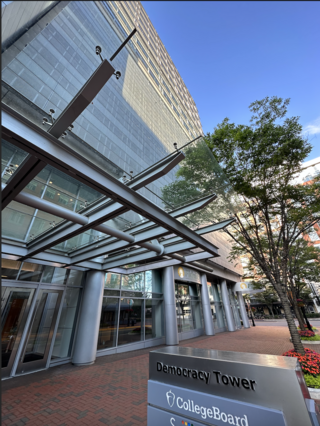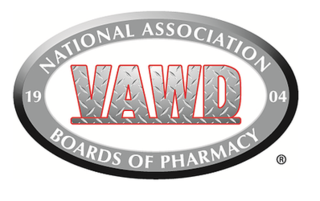
A pharmacist, also known as a chemist in Commonwealth English, is a healthcare professional who specializes in the preparation, dispensing, and management of medications. A pharmacist provides pharmaceutical advice and guidance, often serving as a primary care provider in the community, and offering other services, such as health screenings and immunizations.
The Fundamentals of Engineering (FE) exam, also referred to as the Engineer in Training (EIT) exam, and formerly in some states as the Engineering Intern (EI) exam, is the first of two examinations that engineers must pass in order to be licensed as a Professional Engineer (PE) in the United States. The second exam is the Principles and Practice of Engineering exam. The FE exam is open to anyone with a degree in engineering or a related field, or currently enrolled in the last year of an Accreditation Board for Engineering and Technology (ABET) accredited engineering degree program. Some state licensure boards permit students to take it prior to their final year, and numerous states allow those who have never attended an approved program to take the exam if they have a state-determined number of years of work experience in engineering. Some states allow those with ABET-accredited "Engineering Technology" or "ETAC" degrees to take the examination. The exam is administered by the National Council of Examiners for Engineering and Surveying (NCEES).

The College Board, styled as CollegeBoard, is an American not-for-profit organization that was formed in December 1899 as the College Entrance Examination Board (CEEB) to expand access to higher education. While the College Board is not an association of colleges, it runs a membership association of institutions, including over 6,000 schools, colleges, universities, and other educational organizations.
The United States Medical Licensing Examination (USMLE) is a three-step examination program for medical licensure in the United States sponsored by the Federation of State Medical Boards (FSMB) and the National Board of Medical Examiners (NBME). Physicians with a Doctor of Medicine (MD) degree are required to pass the USMLE for medical licensure. However, those with a Doctor of Osteopathic Medicine degree (DO) are required to take the COMLEX-USA (COMLEX) exams.
The National Council of Examiners for Engineering and Surveying (NCEES) is an American non-profit organization dedicated to advancing professional licensure for engineers and surveyors. The Council’s members are the engineering and surveying licensure boards from all 50 U.S. states, the District of Columbia, Guam, Northern Mariana Islands, Puerto Rico and the U.S. Virgin Islands. These boards are divided into four geographic zones: Central, Northeast, Southern, Western. It is headquartered in Greenville, South Carolina.
Step 2 Clinical Skills of the United States Medical Licensing Examination (USMLE) was an exam administered to medical students/graduates who wish to become licensed physicians in the U.S. It is similar to the COMLEX-USA Level 2-PE exam, taken by osteopathic medical students/graduates who seek licensure as physicians in the U.S. For US medical students, the exam fee is $1,300. For medical students at non-US medical schools, the tests cost is higher—currently $1,535. These fees do not include costs associated with travel and lodging to take the test. Historically, US students have taken Step 2 CS late in their senior year, prior to graduation. However, now that more residency programs require students to record a passing score, many US medical schools recommend students take Step 2 CS in the fall of their senior year.
Southern Regional Testing Agency (SRTA) is one of five examination agencies for dentistry in the United States. Some of the other examination agencies are, Western Regional Examining Board, Central Regional Dental Testing Service, Northeast Regional Board of Dental Examiners. These were organized to better standardize clinical exams for licensure.
The Architect Registration Examination (ARE) is the professional licensure examination adopted by the 50 states of the United States, the District of Columbia, and four U.S. territories. The exam is also accepted by 11 provincial and territorial architectural associations for architectural registration in Canada. The ARE assesses candidates on the knowledge, skills, and abilities required for providing services in the practice of architecture.
The United States Medical Licensing Examination (USMLE) Step 1 is a standardized test that assesses a medical student's knowledge of basic science concepts and their application to clinical medicine. The exam is one of three components required for medical licensure in the United States and is typically taken by students after their second year of medical school.
The National Council Licensure Examination (NCLEX) is a nationwide examination for the licensing of nurses in the United States, Canada, and Australia since 1982, 2015, and 2020, respectively. There are two types: the NCLEX-RN and the NCLEX-PN. After graduating from a school of nursing, one takes the NCLEX exam to receive a nursing license. A nursing license gives an individual the permission to practice nursing, granted by the state where they met the requirements.
The Multistate Pharmacy Jurisprudence Examination (MPJE) is a pharmacy law examination created by the National Association of Boards of Pharmacy (NABP) in the United States to help individual state boards of pharmacy assess the competency and knowledge of pharmacy law. It is required as a prerequisite for a pharmacy license by 48 states and the District of Columbia. Arkansas, California, and Idaho utilize state administered examinations.

The Uniform Certified Public Accountant Examination is the examination administered to people who wish to become U.S. Certified Public Accountants. The CPA Exam is used by the regulatory bodies of all fifty states plus the District of Columbia, Guam, Puerto Rico, the U.S. Virgin Islands and the Northern Mariana Islands.

The National Board of Chiropractic Examiners (NBCE) is a non-profit national and international testing organization for the chiropractic profession that develops, administers, analyzes, scores, and reports results from various examinations. Examinations are offered to students at chiropractic colleges accredited by the Council on Chiropractic Education (CCE). The NBCE maintains its headquarters in Greeley, Colorado. The organization was established in 1963 to standardize chiropractic testing requirements as opposed to each state having its own board exam. Since 1963, all but one of states have adopted the passage of Parts I-IV; however, each state has its own licensing requirements in addition to the NBCE exams.
The basic requirement for pharmacists to be considered for registration is often an undergraduate or postgraduate pharmacy degree from a recognized university. In many countries, this involves a four- or five-year course to attain a bachelor of pharmacy or master of pharmacy degree.
Marshall B. Ketchum University is a private university focused on graduate programs in healthcare and located in Fullerton, California. MBKU expanded from the Southern California College of Optometry which was founded in 1904. The university was officially established as a multidisciplinary university with the addition of School of PA Studies in 2011 and College of Pharmacy in 2013. Along with Hope International University, the campus bookends the north and south sides of the Cal State Fullerton campus respectively.
The 'National Association of Boards of Pharmacy. The NABP membership is composed of 54 active members and 12 associate members. Active member boards include all 50 United States, the District of Columbia, Guam, Puerto Rico, and the Virgin Islands. Associate member boards are The Bahamas, and 10 Canadian provinces. Australia was formerly an associate member but was removed in 2020.
The Examination for Professional Practice in Psychology (EPPP) is a licensing examination developed by the Association of State and Provincial Psychology Boards (ASPPB) that is used in most U.S. states and Canadian provinces.

The Verified-Accredited Wholesale Distributors (VAWD) program was established in 2004 to help protect the public from the threat of counterfeit drugs. The VAWD program was developed and is administered by the National Association of Boards of Pharmacy (NABP). The program offers an accreditation to wholesale distribution facilities by offering an objective, third-party audit system.

An examination or test is an educational assessment intended to measure a test-taker's knowledge, skill, aptitude, physical fitness, or classification in many other topics. A test may be administered verbally, on paper, on a computer, or in a predetermined area that requires a test taker to demonstrate or perform a set of skills.





